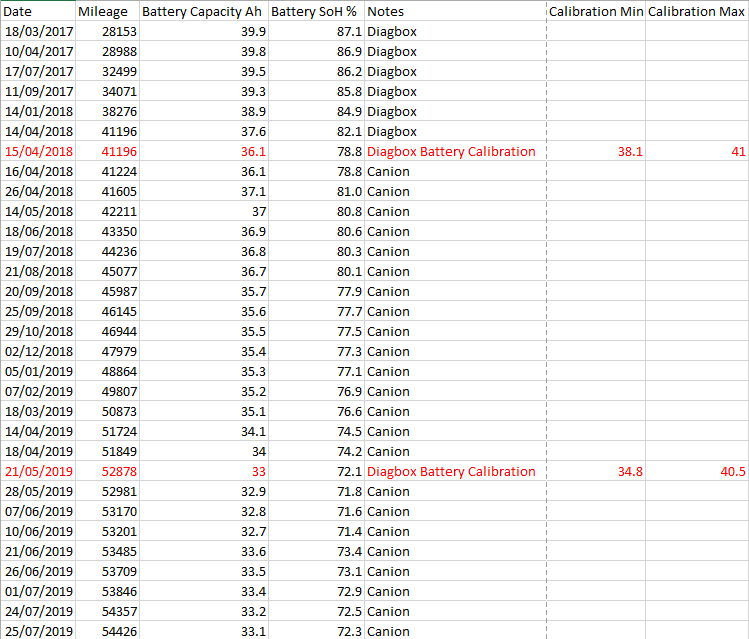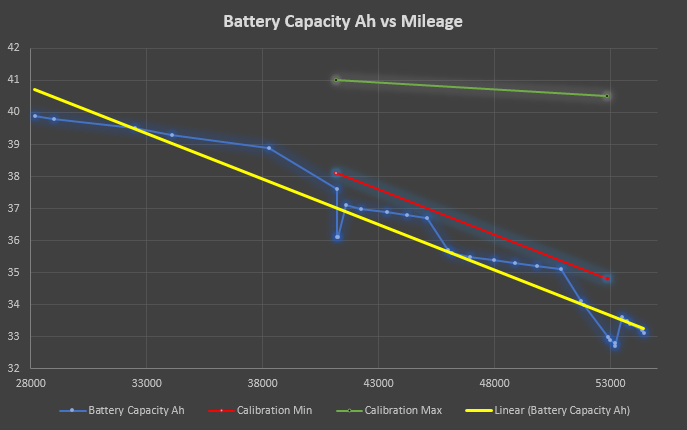Took a while but the first replacement cell has been tested and I'm glad to report it's in good health.

I'm actually recording two different Ah capacity figures from the test of each cell - one from 4.1 volts down to 3.63 volts, and another figure discharging all the way to 3.0 volts.
The reason I did this is because while the raw cell capacity of 50Ah claimed for a new cell according to the data sheet is actually based on a discharge to 2.75 volts, (my charger will only discharge to a minimum of 3.0 volts so I used that) the car itself only ever discharges the cells down to about 3.63 volts or 320 volts for an 88 cell pack, and at 3.63v per cell the pack is considered to be at 0% SoC and the car will shut off.
This is probably done to make sure that the voltage under heavy load does not dip below 3.0 volts, as it would if the unloaded voltage was allowed to go much below 3.63 volts.
So while a discharge to 3.0 volts will give an idea of the raw capacity of the cell outside of the car and in relation to Yuasa's specs, a discharge to 3.63 volts should give a more realistic "usable" capacity that probably matches up with that reported by the BMU, and is thus the figure that matters when compared to what the BMU is reporting.
As it turns out there's only about 3Ah of capacity between 3.63v and 3.0v anyway, so effectively the car is leaving about an 8% buffer below "0% SoC", or perhaps a 10% buffer if you compare it to a discharge to 2.75v. The following voltage curve during a 1.3A discharge shows that 3.63 volts is very close to the "knee" in the voltage curve where the voltage drop starts accelerating:
I've highlighted 3.58 volts on the graph to obtain the time marker not 3.63 because there was about a 5mV drop in voltage across the cables at the 1.3A discharge rate so the cell measured at the terminals was actually 3.63 volts at this time. Looking at the same time mark on the capacity graph we can see that the usable capacity down to 3.63 volts is almost exactly 40Ah:
Full capacity of the cell discharging to 3.0 volts is 43.573Ah. As the BMU reset capacity of the cells is 45.8Ah that means this cell has a SoH of 40/45.8*100 = 87.3%.
Also 43.573/50*100 = 87.1% - a very close match, which fits my theory that 50Ah is the full capacity of the cell when new and 45.8Ah is the "usable" capacity of a new cell in a car due to only discharging to 3.63 volts in operation.
According to the BMU battery calibration I did recently the very best cells in my pack still have a usable capacity of 40.5Ah and the worst ones that I am replacing are down around 34Ah, so the new cell regardless of whether you take the 40Ah or 43.6Ah figure is at least as good if not better than the best cells in my pack, let alone the bad ones they're replacing. :mrgreen:
I'm now doing a 3.8v storage charge of the cell before moving onto the next one, and fingers crossed the other ones are as good as the first...
By the way if you're wondering why my graphs don't begin at zero capacity and the 4.1 volt starting voltage its because the discharge cycle took so long at 1.4 amps that the time counter on the charger unit actually reached 65535 seconds and overflowed, resetting back to 0 seconds and starting the graphs anew from that point. :lol: Fortunately the Ah capacity figure did not reset or rollover as well.
So while the summary page says the discharge took 54908 seconds, it was actually 54,908 + 65,535 = 120,443 seconds or about 33.5 hours. :twisted:



































